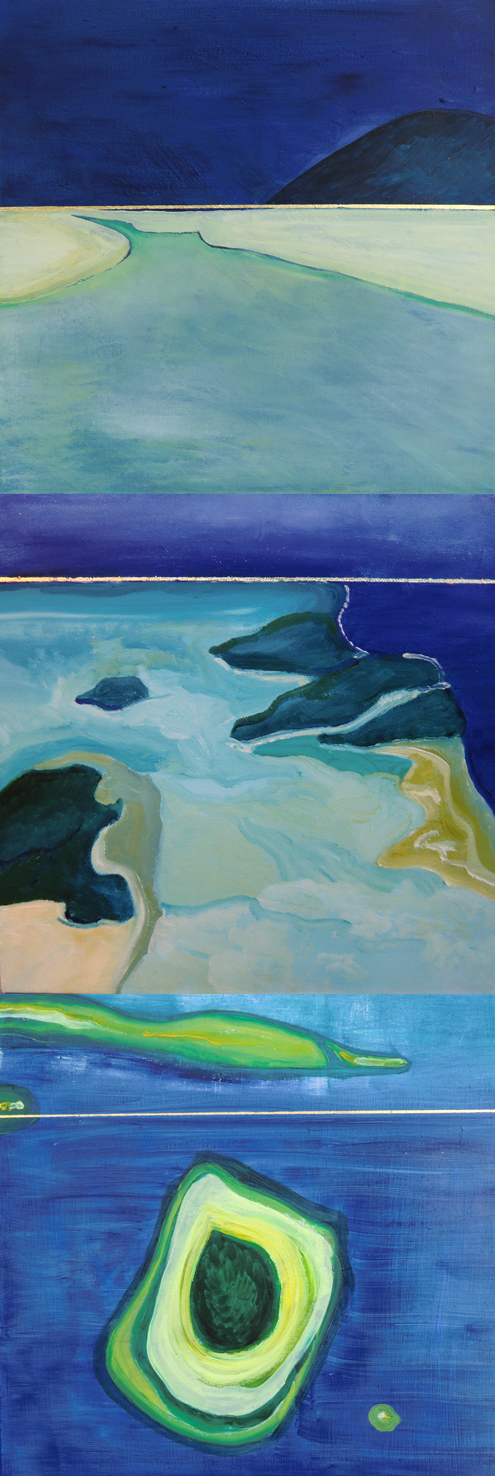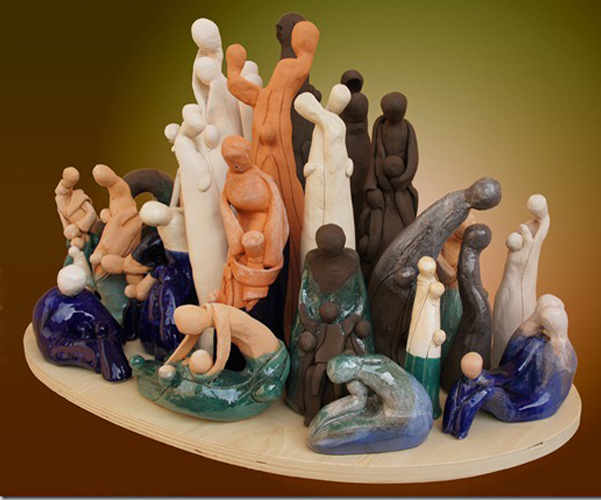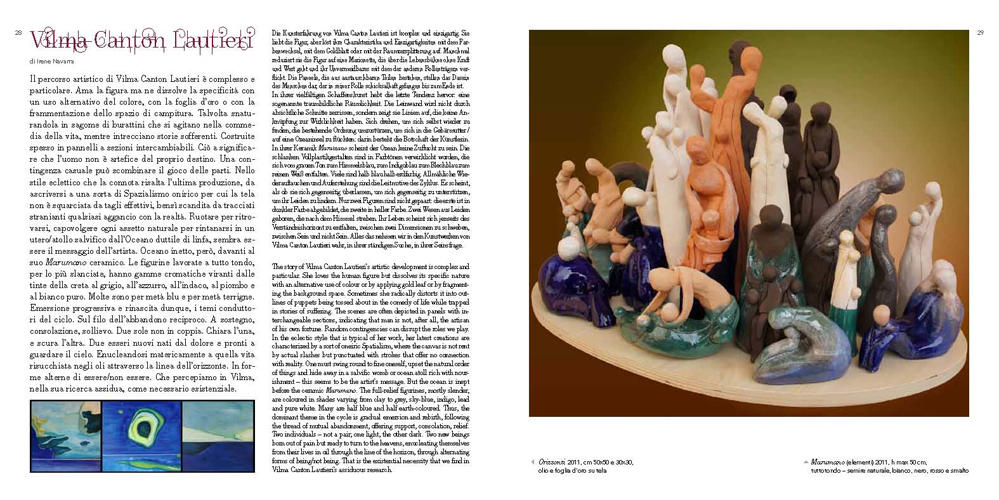Gli Orizzonti di Vilma Canton Lautieri
Il percorso artistico di Vilma Canton Lautieri è complesso e particolare. Ama la figura ma ne dissolve la specificità con un uso alternativo del colore, con la foglia d’oro o con la frammentazione dello spazio di campitura. Talvolta snaturandola in sagome di burattini che si agitano nella commedia della vita, mentre intrecciano storie sofferenti. Costruite spesso in pannelli a sezioni intercambiabili. Ciò a significare che l’uomo non è artefice del proprio destino. Una contingenza casuale può scombinare il gioco delle parti. Nello stile eclettico che la connota risalta l’ultima produzione, da ascriversi a una sorta di Spazialismo onirico per cui la tela non è squarciata da tagli effettivi, bensì scandita da tracciati stranianti qualsiasi aggancio con la realtà. Ruotare per ritrovarsi, capovolgere ogni assetto naturale per rintanarsi in un utero/atollo salvifico dall’Oceano duttile di linfa, sembra essere il messaggio dell’artista. Oceano inetto, però, davanti al suo Marumano ceramico. Le figurine lavorate a tutto tondo, per lo più slanciate, hanno gamme cromatiche viranti dalle tinte della creta al grigio, all’azzurro, all’indaco, al piombo e al bianco puro. Molte sono per metà blu e per metà terrigne. Emersione progressiva e rinascita dunque, i temi conduttori del ciclo. Sul filo dell’abbandono reciproco. A sostegno, consolazione, sollievo. Due sole non in coppia. Chiara l’una, e scura l’altra. Due esseri nuovi nati dal dolore e pronti a guardare il cielo. Enucleandosi matericamente a quella vita risucchiata negli oli attraverso la linea dell’orizzonte. In forme alterne di essere/non essere. Che percepiamo in Vilma, nella sua ricerca assidua, come necessario esistenziale.
Die Kunsterfahrung von Vilma Canton Lautieri ist komplex und einzigartig. Sie liebt die Figur, aber löst ihre Charakteristika und Einzigartigkeiten mit dem Farbenwechsel, mit dem Goldblatt oder mit der Raumzersplitterung auf. Manchmal reduziert sie die Figur auf eine Marionette, die über die Lebensbühne ohne Kraft und Wert geht und ihr unvermeidbares mit dem der anderen Rollenträgern verflicht. Die Paneele, die aus austauschbaren Teilen bestehen, stellen das Dasein des Menschen dar, der in seiner Rolle schicksalhaft gefangen bis zum Ende ist. In ihrer vielfältigen Schaffenskunst hebt die letzte Tendenz hervor: eine sogenannte traumbildliche Räumlichkeit. Die Leinwand wird nicht durch absichtliche Schnitte zerrissen, sondern zeigt sie Linien auf, die keine Anknüpfung zur Wirklichkeit haben. Sich drehen um sich selbst wieder zu finden, die bestehende Ordnung umstürzen, um sich in die Gebärmutter / auf eine Ozeaninsel zu flüchten: darin besteht die Botschaft der Künstlerin. In ihrer Keramik Marumano scheint der Ozean keine Zuflucht zu sein. Die schlanken Vollplastikgestalten sind in Farbtönen verwirklicht worden, die sich vom grauen Ton zum Himmelsblau, zum Indigoblau zum Blechblau zum reinen Weiß entfalten. Viele sind halb blau halb erdfarbig. Allmähliche Wiederauftauchen und Auferstehung sind die Leitmotive des Zyklus. Es scheint, als ob sie sich gegenseitig überlassen, um sich gegenseitig zu unterstützen, um ihr Leiden zu lindern. Nur zwei Figuren sind nicht gepaart: die erste ist in dunkler Farbe abgebildet, die zweite in heller Farbe. Zwei Wesen aus Leiden geboren, die nach dem Himmel streben. Ihr Leben scheint sich jenseits des Verständnishorizont zu entfalten, zwischen zwei Dimensionen zu schweben, zwischen Sein und nicht Sein. Alles das nehmen wir in den Kunstwerken von Vilma Canton Lautieri wahr, in ihrer ständigen Suche, in ihrer Seinsfrage.
The story of Vilma Canton Lautieri's artistic development is complex and particular. She loves the human figure but dissolves its specific nature with an alternative use of colour or by applying gold leaf or by fragmenting the background space. Sometimes she radically distorts it into outlines of puppets being tossed about in the comedy of life while trapped in stories of suffering. The scenes are often depicted in panels with interchangeable sections, indicating that man is not, after all, the artisan of his own fortune. Random contingencies can disrupt the roles we play. In the eclectic style that is typical of her work, her latest creations are characterized by a sort of oneiric Spatialism, where the canvas is not rent by actual slashes but punctuated with strokes that offer no connection with reality. One must swing round to fine oneself, upset the natural order of things and hide away in a salvific womb or ocean atoll rich with nourishment – this seems to be the artist’s message. But the ocean is inept before the ceramic Marumano. The full-relief figurines, mostly slender, are coloured in shades varying from clay to grey, sky-blue, indigo, lead and pure white. Many are half blue and half earth-coloured. Thus, the dominant theme in the cycle is gradual emersion and rebirth, following the thread of mutual abandonment, offering support, consolation, relief. Two individuals – not a pair; one light, the other dark. Two new beings born out of pain but ready to turn to the heavens, enucleating themselves from their lives in oil through the line of the horizon, through alternating forms of being/not being. That is the existential necessity that we find in Vilma Canton Lautieri's assiduous research.
Irene Navarra / Quaderni di critica / Artemisia Eventi Arte / Vilma Canton Lautieri/
9 ottobre 2013
Traduzioni in tedesco di Marina Bressan, in inglese di Chiara Santesso


